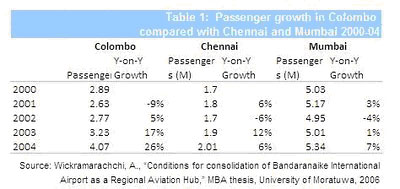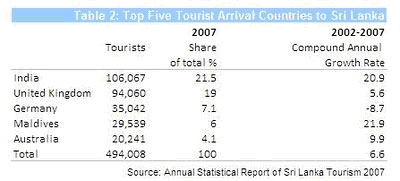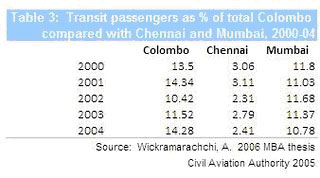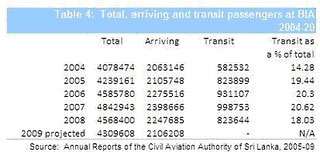
16/03/2010 – Business Talk |
|||
| Consolidating Colombo, Sri Lanka as an aviation hub | |||
|
Sri Lanka is to become a "Naval, Aviation, Commercial, Energy and Knowledge hub." We are already an incipient aviation hub for the southern Indian region, including the Maldives. How did we get here? How can we build on what has been achieved? How did we get here? First, the government reformed airport operations with the creation of Airport Aviation Services Limited (AASL) as a government owned company in 1983, with the intention of allowing it to function efficiently, unshackled from government administrative culture. That structure was a distinct improvement from what existed before, and the airport was for several years superior to its Indian peers (though of course not to Singapore, Bangkok, etc.). Airports compete with other airports in the region. To stand still is to fall back. Anyone who has seen the Rajiv Gandhi International Airport in Hyderabad (http://www.newhyderabadairport.com/) will understand the need for reforms in the management of the Bandaranaike International Airport. While the physical infrastructure has been much improved in the past few years, the organization is now showing the ill effects of abuse of power for political and venal purposes and the creeping recolonization by government mindsets. Concrete and jetways do not an aviation hub make. An aviation hub is one where transit occurs. Many passengers come to a hub airport not because they want to visit the country where the airport is located, but because they wish to catch another plane. The airport makes money from the services it provides these transit passengers and to the airlines that carry them. The people from the country where the airport is located and who use it as their primary connection with the world benefit because the transit traffic justifies a much richer schedule of direct flights to a range of destinations. The BIA is an incipient hub because even today SriLankan Airlines brings in a lot of passengers who are travelling to/from India. Some of these people do not leave the airport at all, connecting to flights that leave immediately after they arrive. Others do leave the airport, staying in hotels for a few hours or longer, before coming back to catch a flight. This (as well as the attraction of Indians to Sri Lanka as tourists) was made possible by the initiative taken by the then Minister for Economic Reforms, Milinda Moragoda, back in 2002 to allow visa-on-arrival to Indian visitors, despite the stubborn refusal of the Indian Foreign Service bureaucracy to relax visa requirements for Sri Lankans visiting India. |
|||
 |
|||
|
Table 1 shows the results, with Colombo recovering faster from the worldwide decline in air travel caused by 9/11, even though it was hit doubly hard because of the LTTE’s airport attack. Unilateral liberalization of the visa regime yielded immediate benefits in terms of tourism (India rising to become the largest market, with one of the highest growth rates), but also created the conditions for Colombo to emerge as an incipient regional aviation hub. |
|||
 |
|||
|
The India Sri Lanka Comprehensive Economic Partnership Agreement (CEPA) process which was initiated through a 2003 joint study report with major contributions from the Ministry for Economic Reform, Science and Technology was intended to lock in these benefits. Though the report preceded the negotiation of the CEPA proper, it yielded immediate benefits by liberalizing the aviation market in 2004. The Sri Lanka-India routes were liberalized with permission being granted to Indian private airlines to fly into Colombo and constraints were lifted on flights into India by airlines from Sri Lanka. The combined results of the visa and market liberalizations can be seen in the accelerated growth of passengers going through Colombo in 2004 (Table 1) as well as in the rapid increase of transit passengers in Colombo, pulling ahead of India’s principal gateway airport, Mumbai (Tables 3 and 4). |
|||
 |
|||
|
Table 4 shows that the rapid growth of transit passengers plateaued by 2008, along with overall passenger traffic, indicating that the momentum of 2002-04 is running out. More reforms are urgently needed if Colombo is truly to achieve hub status. |
|||
 |
|||
|
preoccupation with the war and the lack of a consistent focus has allowed some of Colombo’s lead to shrink. For example, Jet Airways is in the process of converting sleepy Chennai airport into a hub, connecting even Sri Lankan passengers to its direct flights to Europe and beyond through the Anna International Terminal. For inexplicable reasons, the government balked at signing the CEPA. It has so far failed to implement a good regulatory regime for BIA, still governed by archaic monopoly arrangements for ground handling services. The unpardonable and avoidable mess of Mihin Lanka has cast a pall on the entire industry. The management turmoil caused by trying to renationalize SriLankan and the resultant financial crisis have made it even less likely that it could be weaned from its reliance on ground-handling profits to reduce losses from flying operations. In 2004, the Civil Aviation Authority Annual Report contained comparative data on ground handling charges in Colombo vis-à-vis regional competitors which showed that the charges here were, for the most part, too high. A similar study does not appear to have been conducted since the departure of the then DGCA, Mr H.M.C. Nimalasiri, perhaps because of the sensitivity of the topic. How can we build on what has been achieved? We are close to India, but are not India. We are small and therefore have the potential to be nimble and fast. Despite many shortcomings, the airport still works a little better than most of its counterparts in India. These are the central truths we must work from, if we are to at least keep up with the Indian economic juggernaut, now that it has been awakened from its long licence-raj slumber. Hubs cannot be decreed into existence. Hubs emerge because the economics are right. They disappear when the economics go wrong. In the 1950s and 1960s, Singaporeans came to Colombo to connect to flights to Europe. Since the 1970s, we have been going to Singapore to connect to flights. The decline of Colombo and the rise of Singapore were based on massive investment, good regulation and public-private partnerships. If Colombo is to rise again, merely talking about making it a hub will not do. We will need a laser-like focus on the increasing investment through public-private partnerships and in creating a modern regulatory regime for airport and aviation services that will facilitate investment and efficiency. Some of the investments are being done; others need to be done. Currently, aircraft have to carry extra fuel when coming to Colombo because the nearest alternative airports (Male and Chennai) are more than one hour away. The construction of the Mattala Airport will remedy this problem. But there is still the need for a second runway, arguably even more important than the alternative airport. Anyone who has seen a real hub airport will appreciate that we do not have enough gates to justify being called a hub. Construction must begin now of another terminal at BIA. All this requires investment. It is best that this come from willing private entrepreneurs, rather than from the government’s meager budget. The path is not one of greater reliance on government, but on public-private partnerships, on the lines of what is being done in the major international airports of India. Hyderabad becoming the world’s fifth best airport in 2010 is a wake-up call. Even if the early results are going to be disappointing it is imperative that Colombo join the ASQ rankings. If even Chennai has the guts to be assessed against the competition, why not Colombo? Colombo’s future as viable regional hub airport depends on continuing progress on reforming the airport and introducing competition. Infrastructure reforms must not depend on which government is in power. The actions that made Colombo an incipient aviation hub were taken by previous UNP governments, other than the privatization of SriLankan Airlines in 1998. It is heartening that the current President has, in addition to giving priority to the construction of an alternative airport, made the aviation hub a centerpiece of his second term. The Mahinda Chintana Idiri Dekma lays out the vision of what is to be achieved, but is thin on how it is to be achieved. The how is spelled out in the “Sri Lanka National Congress Agenda for Influencing the Government,” the manifesto of Milinda Moragoda’s campaign in 2010. The relevant actions include:
One hopes that there will be bipartisan consensus on the next stage of making Colombo an aviation hub for the southern Indian region, including the Maldives, and that the consensus will be translated into right actions and consistency of purpose. |
|||